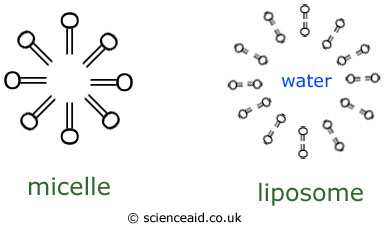Lipids
Lipids are fats and oils, they are important to living things because they form membranes. They are made of carbon, hydrogen and >oxygen.
Triglycerides
Below is a diagram of a glycerol molecule and then a fatty acid. These are two important parts in creating a triglyeride.

The glycerol is a simple molecule. The fatty acid consists of a methyl group, a hydrocarbon chain which can be from 14 to 22 carbon atoms long (but always an even number), and it ends in a carboxyl group. However the methyl group can be considered part of the hydrocarbon chain, and known collectively as the R group. Therefore the fatty acid can be written like this...
RCOO-
The carboxyl end of the fatty acid is polar and so it is hydrophillic (it likes water)
The fatty acid with only single bonds between the carbon molecules is said to be saturated because they are saturated with hydrogen. However, if there are double bonds between carbon molecules (C = C = C) all of it's bonds are used up and no hydrogens can get in, this means in is unsaturated.
And now, we will create a triglyceride. This is simply one glycerol plus three fatty acids which make a structure that looks a bit like this:

It is an example of a condensation reaction where 3 water molecules are lost for every one molecule of triglyceride produced.
Phosphlipids
A phosphlipid is similar in strucuture to the triglyceride but instead of one of the fatty acid chains, it has a phosphate .

As you can see the phosphate part is polar, and so is hydrophillic. When it comes into contact with water the 'tails' of the phospholipid face each other, with the 'heads' facing outwards. This structure is called a micelle
Alternatively, the phospholipids might form a phospholipid bilayer (similar to that seen in cell membranes). This is a ring of phospholipids surrounding an area of water. This structure is called a liposome.

Updated: 15 May 2011.
